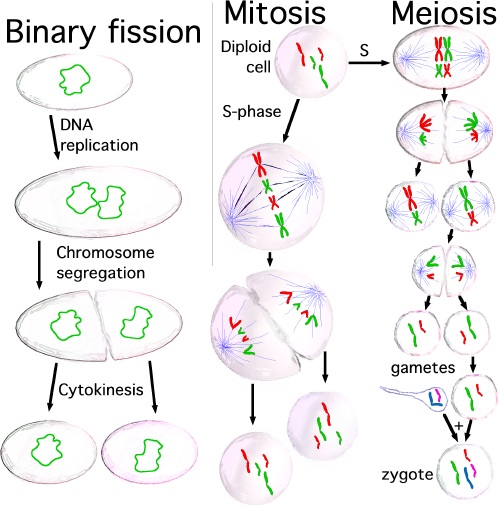Daughter Cells Definition
Daughter cells are produced after a single cell undergoes cell division. During mitosis, one pair of daughter cells is created after one round of DNA replication. During meiosis, a single round of DNA replication is followed by 2 rounds of cell division. This creates two sets of daughter cells, each of which has a haploid genome.
“Daughter cells” is a bit misleading, because the new cells are not the offspring of the original cells. In this sense, daughter cells fails to portrait was is actually happening at the cellular level. A “daughter cell” in this sense would mean that the cells are combining their genetics to create a new cell. In fact, the opposite is happening. In mitosis, a single cell becomes two identical cells. Daughter cells in this sense are actually closer to clones. In meiosis, a single cell becomes 4 cells, each with reduced DNA. This process creates gametes, which can then fertilize each other to create actual offspring. These processes can be seen in the image below.

Daughter cells, and their naming, comes from early cell biology, when the actual processes behind cell division were poorly understood, and the name has stuck. Now, we have a much clearer understanding about how cells divide.
How Daughter Cells Are Created
In the broadest overview of cell division, the process is simple. Every substance, structure, and particle in the cell must be accumulated, copied, and divided. This means that before any cell division or daughter cells, the original parent cell must grow. The cell’s machinery have evolved to take nutrients and atoms from the environment, and incorporate them into the cell. When the cell reaches a certain size, a genetic switch gets thrown, and kicks the cell into division mode.
The cell first goes through the process of DNA replication. The DNA is “unzipped” by special proteins, which break the hydrogen bonds between nucleotides. When each single strand is exposed, an opposing strand is created. When this process is complete, the cell contains 2 copies of the DNA. Now, it can start to create daughter cells.
During growth, the organelles and specialty proteins were replicated and stocked up. As the cell enters the process of mitosis, the DNA condenses. It forms into densely packed chromosomes, which can be separated appropriately into the daughter cells. Spindle fibers, forming from the centrioles, reach out across the dividing cells and attach to various chromosomes, organelles, and other structures. As these microtubule mechanisms retract, the components of the daughter cells are dragged to opposing poles in the dividing cell.
The end of cell division, telophase and cytokinesis, includes the actual separation of the cellular membrane, marking the creation of the new daughter cells. Thus, unlike during the creation of offspring, in the creation of cells the “parent” cell is directly divided into the new cells. This is in contrast to a parent producing an offspring and staying intact. While the term is a little confusing, it is simply a way to track which cells were derived from which cellular lines.
Symmetric and Asymmetric Daughter Cells
Not all cell divisions end with perfectly identical daughter cells. This might be the case with normal mitosis, such as a cell division to replace a dead skin cell. These daughter cells would be almost identical to the parent cell, which is also a skin cell. However, all of these cells came from a single parent cell, the zygote.
After the fusion of two gametes, the zygote contains all the necessary genetic material for an entire organism, bundled into a single cell. This single parent cell is completely unspecified. The daughter cells it creates will also be very generalized. These cells are known as stem-cells. They are totipotent, meaning they can become any cell in the body. This process repeats continually as the embryo grows, and eventually the cells start to differentiate into more specific body parts.
This process takes place via asymmetric cell division. In this case, the daughter cells are not the same. One daughter cell resembles the generalized, stem-cell parent. The other cell expresses a different part of the DNA, and starts to take on specialized characteristics. This could be any tissue, such a lung, bone, or muscle. Each tissue type has a stock-pile of these more specific cells, which then become a stem-cell line for that specific tissue type. These asymmetric cell division are what powers the variety of life on Earth, and are not fully understood.
Thus, not all daughter cells are necessarily perfect copies of their parent cell. Even in normal mitosis, random events and mutations can lead to two daughter cells which are not identical. While the consistency of creating daughter cells is what continues the process of life, it is often the mutations and alterations which allow life to adapt and evolve to a changing environment.
Quiz
1. Two cells are placed in a healthy nutrient solution. Each cell will divide every 12 hours. The scientist waits 2 days, then counts the cells. How many daughter cells are there?
A. 8
B. 16
C. 32
2. Two students are arguing. One says that meiosis produces 4 daughter cells. The other says it produces 0 daughter cells, because none are identical. Which theory is correct?
A. 4 Daughter Cells
B. 0 Daughter Cells
C. Neither theory
3. True or False: Bacteria create daughter cells.
A. True
B. False
References
- Hartwell, L. H., Hood, L., Goldberg, M. L., Reynolds, A. E., & Silver, L. M. (2011). Genetics: From Genes to Genomes. Boston: McGraw Hill.
- Lodish, H., Berk, A., Kaiser, C. A., Krieger, M., Scott, M. P., Bretscher, A., . . . Matsudaira, P. (2008). Molecular Cell Biology (6th ed.). New York: W.H. Freeman and Company.
- Nelson, D. L., & Cox, M. M. (2008). Principles of Biochemistry. New York: W.H. Freeman and Company.
